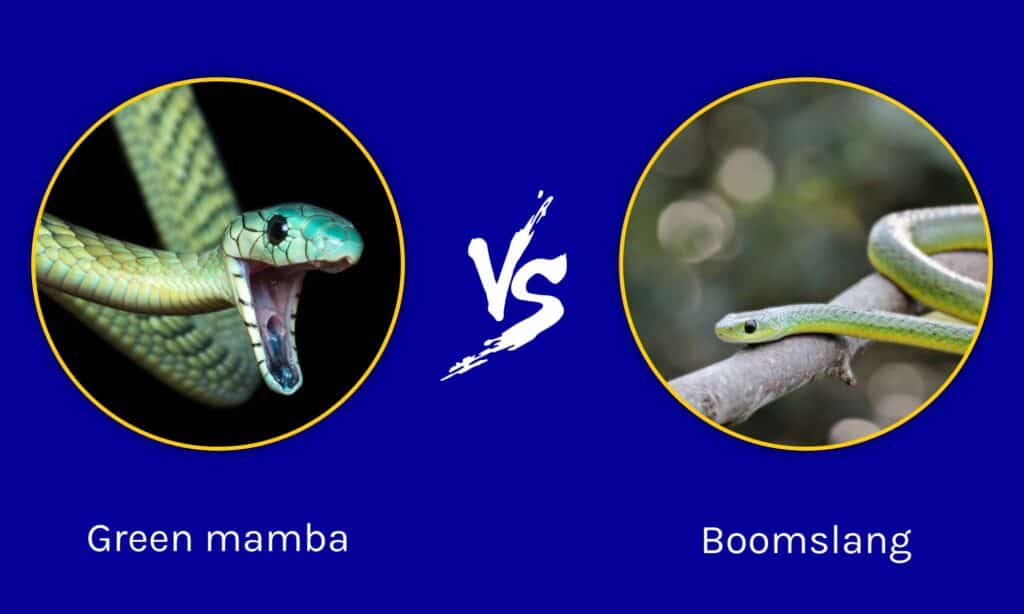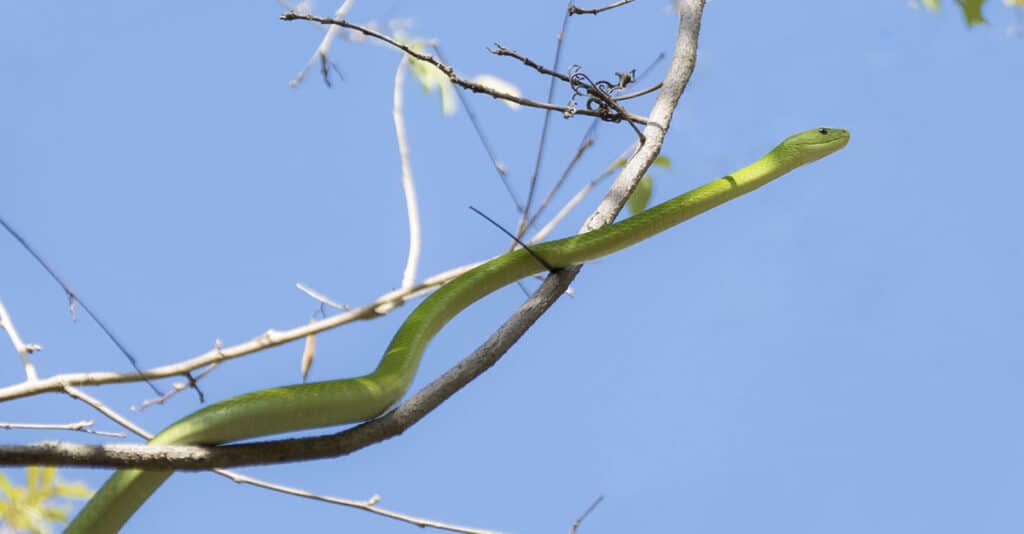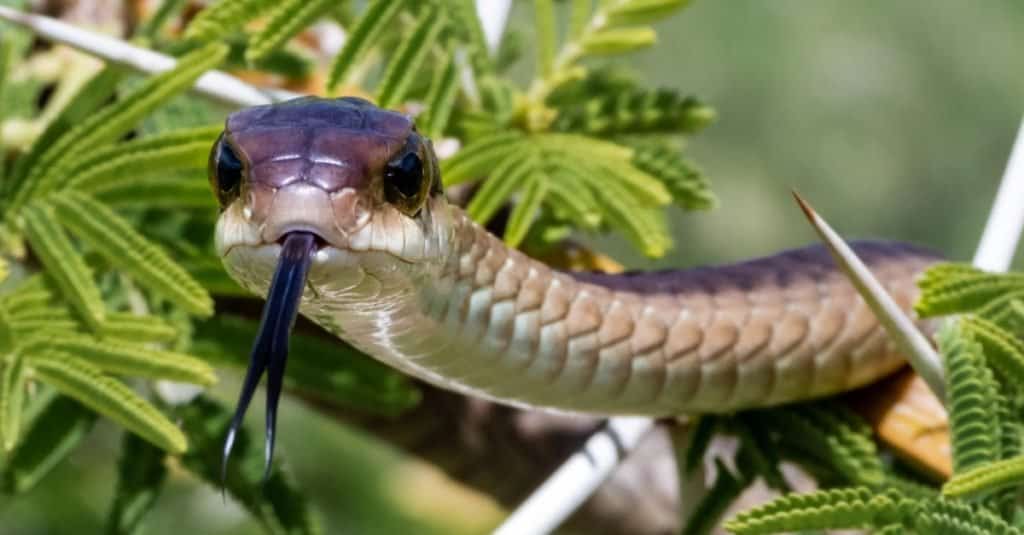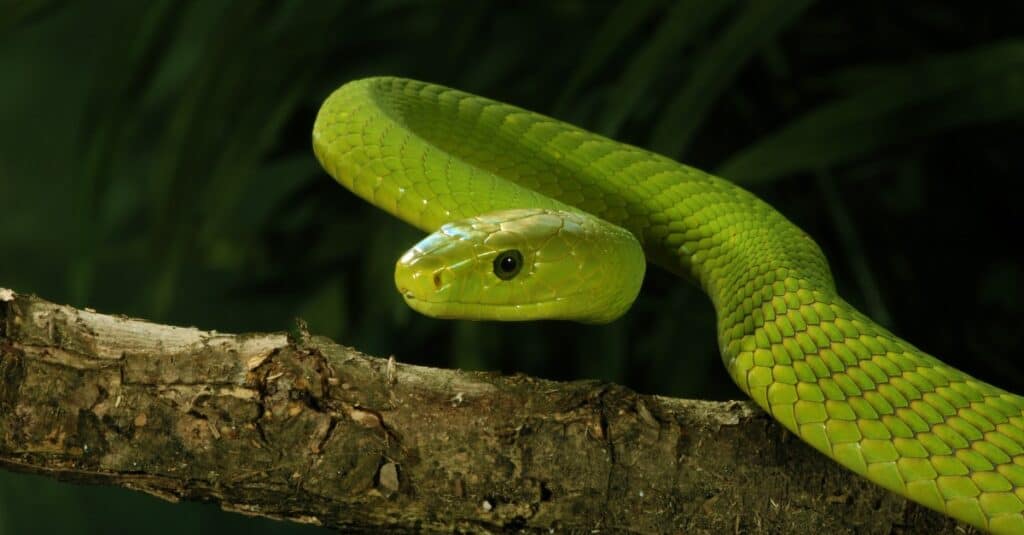Green mambas and boomslangs look so similar that it can be easy to confuse them at a glance. Both species of snakes are beautiful, green, slim, and deadly. Boomslangs and green mambas are highly venomous snakes usually found in Africa, and they spend most of their time up on trees. Besides, these reptiles are the only two deadly green snakes in the world out of the six green snakes that exist. Do you want to know more about these beautiful but poisonous creatures and what differentiates them from one another? Yes? Let’s explore the differences between both species.
Comparing a Green Mamba to a Boomslang

| Green Mamba | Boomslang | |
|---|---|---|
| Size | Weight: between 1kg to 1.6kg (2.2lbs to 3.5 lbs) Length: between 4ft to 7ft | Weight: between 175g to 510g (0.4 lbs to 1.1lbs) Length: 3.1ft to 5.3ft |
| Scientific name and family | Dendroaspis angusticeps They belong to the Elapid Snakes family. | Dispholidus typus They belong to the Colubrid Snakes family. |
| Color | Usually bright, glossy green | They come in various shades of green, from dark green to dusty green to bright green. |
| Venom | Their venom contains neurotoxins and cardiotoxins | Their venom contains hemotoxins |
| Distribution | These snakes are commonly found in Western Africa | These snakes are commonly found in Southern Africa. |
The Key Differences Between Green Mamba and Boomslang
The key differences between green mambas and boomslangs lie in their size, appearance, color, and venom. Green mambas are generally heavier, longer, and deadlier than boomslangs. Looking at boomslangs and how slender and pretty they are, it can be difficult to believe that they are as deadly as they actually are. It’s very easy to get mixed up if you are not an expert in snakes, but they have some very fundamental differences.
Let’s go deep into the key differences.
Green Mamba vs Boomslang: Appearance

Green mambas have slender bodies with smooth scales.
©Ewout Knoester, some rights reserved (CC-BY-NC) – License
Typically, the green mamba is a long snake with a slender body and a surprisingly heavy bodyweight for its looks. It has a narrow head shaped like a coffin, and it has smooth scales. Green mambas have short fangs in front of their mouth, and light green scales cover their darker green bodies. They grow to about 4 ft to 7 ft long, and the female species are often bigger than the males.
The boomslang is a slender, fragile-looking snake with a large, blunt head that is quite distinct from the neck. A defining feature of this snake is its large eyes placed right on top of its head. This snake species doesn’t grow so long, and the length usually ranges from 3.1 ft to 5.3 ft. However, it is rare to see a boomslang that is up to 5.3ft tall.
Green Mamba vs Boomslang: Color

The boomslang can come in different colors.
©Willem Van Zyl/Shutterstock.com
Green mambas are usually very bright green, with some of them having black keels on their heads. Their bellies are typically light green to yellow. Some are just regular green anyway.
Boomslangs have more colors than green mambas as they can blend in with their environment. They come in many shades of green – the male species can also come in rust-red or black and yellow. The females can come in dark grey or dusty olive-brown. Interestingly, the most beautiful boomslangs are the little ones. They have twig-colored bodies, very bright, shiny emerald eyes, and their throats are snow-white.
Green Mamba vs Boomslang: Venom

Green mambas venom contains cardiotoxins and neurotoxins.
©iStock.com/through-my-lens
These snakes have highly toxic venom; they are definitely not snakes you want to take a selfie with. The green mamba’s venom contains cardiotoxins and neurotoxins. These toxins cause quick respiratory paralysis because they affect the brain and heart. If left untreated for a short period of time, their bites can induce death.
Boomslangs are toxic but not as toxic as green mambas. The boomslang’s venom contains hemotoxins which seriously affect the blood. Their venom prevents the blood from clotting, and if left untreated for a long time, the victim can die.
Green Mamba vs boomslang: Distribution
Although both species are found in Africa, green mambas have a smaller distribution than boomslangs. Where you find the green mamba depends on the species you want to see. The western green mamba can be found in the woodlands and tropical rain forests of southern areas of West Africa, while the eastern green mamba can be found along the coasts of East Africa (from South Africa to Kenya). Usually in the coastal bushlands and woodlands.
Green Mamba vs Boomslang: Diet
Both of these snakes are carnivorous in nature. Green mambas are naturally solitary animals – they love to stay on their own. Hence, they love to do their hunting alone. They eat rodents, lizards, frogs, birds, eggs, and small mammals that they can easily dominate and crush.
Boomslangs eat the same things as green mambas, and they are more active and outgoing than green mambas. The fact that these snakes don’t prey on large animals doesn’t mean that you should underestimate them. Avoid them at all costs because if they get a hold of you, it will just be too bad.
Green Mamba vs Boomslang: Tree Hugging
Both of these species of snakes love to stay on trees. They spend the major part of their lives on trees, only coming down when they need to hunt for food, water, and forage.
Green Mamba vs Boomslang: Mating
Green mambas usually have many mates; they are not loyal to just one mate like some animals. When it’s time to mate, a male green mamba will locate its female by following her scent trail. Females usually have a lot of males wanting to mate with them, so the males have to wrestle with themselves to know who will bed the “lady.”
The competition isn’t usually violent – it doesn’t involve biting. It’s just a competition where one male has to make the other submit. The male who wins mates with the female who will later lay about 4 to 17 eggs. It takes about 10 weeks to 12 weeks for the eggs to hatch.
The boomslang has the same mating process as the green mamba, but the females lay about 8 to 27 eggs with soft shells about the size of a ping pong ball. And it takes about eight weeks to 14 weeks for the eggs to hatch.
The photo featured at the top of this post is © Dylan leonard/Shutterstock.com
Discover the "Monster" Snake 5X Bigger than an Anaconda
Every day A-Z Animals sends out some of the most incredible facts in the world from our free newsletter. Want to discover the 10 most beautiful snakes in the world, a "snake island" where you're never more than 3 feet from danger, or a "monster" snake 5X larger than an anaconda? Then sign up right now and you'll start receiving our daily newsletter absolutely free.
Thank you for reading! Have some feedback for us? Contact the AZ Animals editorial team.







